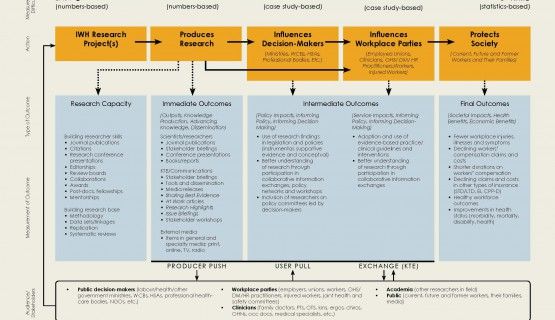Since the Institute for Work & Health established research transfer and exchange (KTE) as part of its core business alongside research in 1998, we have been developing and growing our expertise in the area. What we have learned and how we practice KTE is available in a number of IWH-authored resources, listed below.

Promoting evidence-informed practice and practice-informed research: A planning guide for knowledge transfer and exchange
In the spring of 2024, IWH launched a new guide to help researchers and organizations plan KTE strategies to enhance the relevance, quality and use of their research to inform policy or practice. The guide is informed by the research literature on KTE and the practice of KTE at IWH.

IWH research impact model for work and health: article
In 2020, the American Journal of Industrial Medicine published an article by Institute KTE and communications experts that explains the IWH Research Impact Model, which guides the measurement of our impact and related impact case studies.

Approach to knowledge transfer and exchange at IWH: article
In 2017, the journal Scholarly and Research Communication published a paper by KTE experts at the Institute for Work & Health that outlines our integrated approach to KTE, and how we bring both stakeholder engagement (e.g., networks, outreach, one-on-one meetings, group presentations) and communications functions (e.g., website, newsletters, media releases, social media) under one umbrella.

Approach to knowledge transfer and exchange at IWH: presentation
At the December 2017 meeting of the Prevention Knowledge Exchange Group, a forum for discussion about the use and dissemination of research relevant to Ontario's prevention system, IWH's KTE director outlined the Institute's theory and practice of knowledge transfer and exchange.

IWH communications survey: results
In 2015, IWH conducted a survey to learn about the communication preferences and practices of people working in occupational health and safety (OHS) and disability management. The survey, completed by over 1,000 people, asked about the information formats and dissemination vehicles they prefer and use most often to get the OHS-related information they need.

Finding tools to measure the impact of KTE activities
The effectiveness of current KTE practices has not been routinely or consistently evaluated, in part because of a lack of instruments for assessing the impact of KTE activities. An IWH systematic review, published in 2011, searched the literature to find instruments that can accurately and reliably measure KTE activities. Although few were found, some showed promise.

Promising KTE evaluation tools
The 2011 systematic review to find tools that effectively measure the impact of KTE activities concluded that few well developed instruments are available (see above). However, it did find 16 articles describing instruments that showed promise as useful tools in the evaluation of KTE activities.

From research to practice: a KTE planning guide
This practical guide, published in 2006, is designed to help with knowledge transfer planning, based on a model that promotes building and nurturing relationships between those who produce research and those who use it. The short guide, written by experts and pioneers in KTE, includes advice and worksheets on creating messages, understanding audiences, transferring knowledge, and defining impacts.

Building the knowledge base
This report details the eight key messages arising from the Ontario Regional Knowledge Transfer and Exchange Workshop that took place in 2005. The workshop was set up after the Canadian Health Services Research Foundation issued a call for proposals to bring together knowledge brokers regionally to support the development of KTE capacity.